Custom Software Development: Step-by-Step Guide

Starting in the world of customized software development might seem intimidating, yet this guide will help clear things up. It makes a big difference for business owners and tech enthusiasts to know how tailored solutions can change the way they work.
Custom software development calls for clarity in scope and purpose. When you build with strong software engineering foundations, you avoid wasted time, bloated features, and misaligned expectations. The best systems come from simple ideas executed well.
Developing custom software allows teams to use products built exactly for them that match their unique needs and strategies. These unique systems are meant to give the best support and not to fit everybody. Having a good strategy means that tailor-made software products can serve your company as a valuable asset and not only as a tool. Discover how Limeup’s custom software solutions can help you turn plans into products that deliver.
What is custom software development?
The term we are talking about today is maintaining and adjusting software that is made for a unique use. Off-the-shelf software is meant to fit all kinds of businesses, whereas a custom solution is specially made to fit a particular business’s needs, aims and audience. It’s the difference between writing a proprietary algorithm instead of using an open-source shortcut.
A basic principle is that when the developers have specialized work, their standard tools are not enough. A system set up specifically for a company can lessen difficulties, make operations smoother and allow growth with time.
Custom software engineering deals with specific problems and nothing else. Tuning things just right means cleaner processes, fewer vulnerabilities, and smarter alignment with what’s already working.
The stages usually include discovery, planning, designing the interface, developing, testing, deployment and continuous support (we will discuss them more precisely later). The product is modified and updated at each point with help from feedback, its performance and any strategy changes. Agile approaches usually direct development so you can change the process quickly and easily if required.
For businesses that have formed workflows and are growing online, custom software development services become very useful. And it is no wonder as people now prefer software built for their particular needs, instead of using the same general solutions.
These positive outcomes follow one another quickly. There are no recurring fees and no rules on how you can use the product. It is up to you to determine the features and guide the updates as you like. Most importantly, you avoid being locked into someone else’s roadmap.
Custom development is able to create software for CRMs, warehouses, client portals and many other systems. Businesses that desire dependable and original solutions in technology usually seek help from the best software development companies in the UK. Smart partnerships speak for themselves: simple to use, hard to shake, and always on point when needed most.
Types of custom software solutions
Unique to each business are these applications’ goals, methods and customers, so they are more powerful than any generic option. Let’s break down the different types of tailored software engineering and why they often outpace ready-made options.
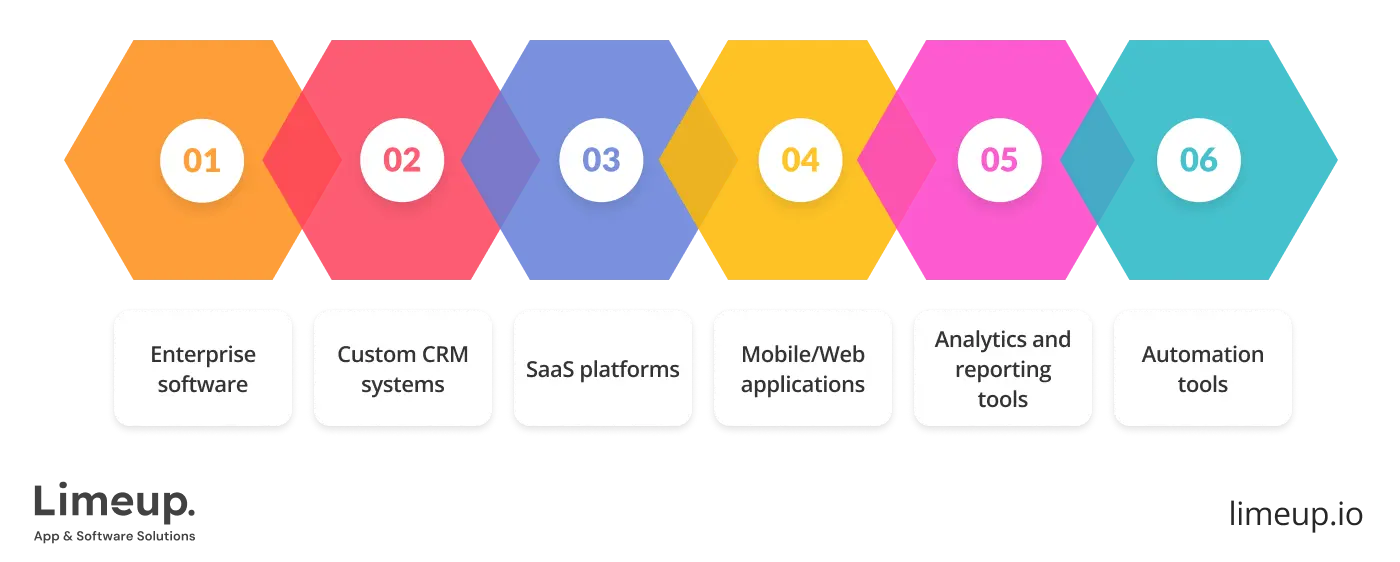
- Enterprise software. What’s inside? Only the tools that matter like workflow drivers, budget controllers, and inventory insight, purpose-built and precision-aligned.
- Custom CRM systems. CRM technology allows sales and support teams to keep records of who they meet, manage leads and control how they deal with clients based on your organization’s structure.
- SaaS platforms. Each interface is calibrated for a specific audience, removing digital friction and enabling users to engage with clarity and purpose.
- Mobile and web applications. Launched in real-time environments, these platforms strike a fine balance between streamlined aesthetics and complex, enterprise-tier logic. Every interaction is intentional — pared-down on the surface, yet deeply engineered under the hood.
- Analytics and reporting tools. See what matters, skip what doesn’t. These utilities strip out distraction and put data storytelling on rails, letting critical insights rise to the surface where they belong.
- Automation tools and workflow systems. Precision-coded infrastructure that manages the operational maze — automating steps that don’t need a human touch but still demand absolute accuracy. From onboarding logic to payment flows, it’s workflow without the footwork.
Off-the-shelf vs custom software
These tools are convenient, but they are not very accurate. You have to change your way of working to follow another developer’s approach. Custom-built digital solutions flip the script — built around how you operate, not how you’re supposed to.
A tailor-made solution gives you control, flexibility for years to come, and allows the platform to change as your business does. All your integrations go smoothly, and the updates happen just as you want them.
Mainstream strategies for strategy development find it tough to follow changes quickly. From the beginning, custom development makes sure you have the right tools in hand, and helps you stay adaptable as changes in the market happen.
| Criteria | Shelf-ready tech | Custom software |
| Fit with business | Generic fit for broad industries | Designed to match your processes and goals |
| Cost control & transparency | Hidden fees for upgrades and integrations | Clear ownership of costs and roadmap |
| Control over features | Vendor decides what’s included | You define priorities and functionality |
| Innovation potential | Same stack competitors use | Unique to your operations |
| Time to launch | Faster to deploy | Built to fit, takes longer |
Pre-built tools set boundaries. Custom software redraws the blueprint. If agility, control, and future-proofing are priorities, bespoke development puts you in the driver’s seat.
When do you need custom software?
It’s not always possible for businesses to succeed with out-of-the-box technologies. While using assembly-line software can be helpful at the beginning, it usually fails when the project requires more effort. All growing companies sooner or later hit a critical point: either adjust your business to work with the software or build custom software that works perfectly with how you do business.
Here’s when client-specific solutions step in to help. And if you’re reading this, chances are you’re already on the brink of outgrowing one-size-fits-all tools.
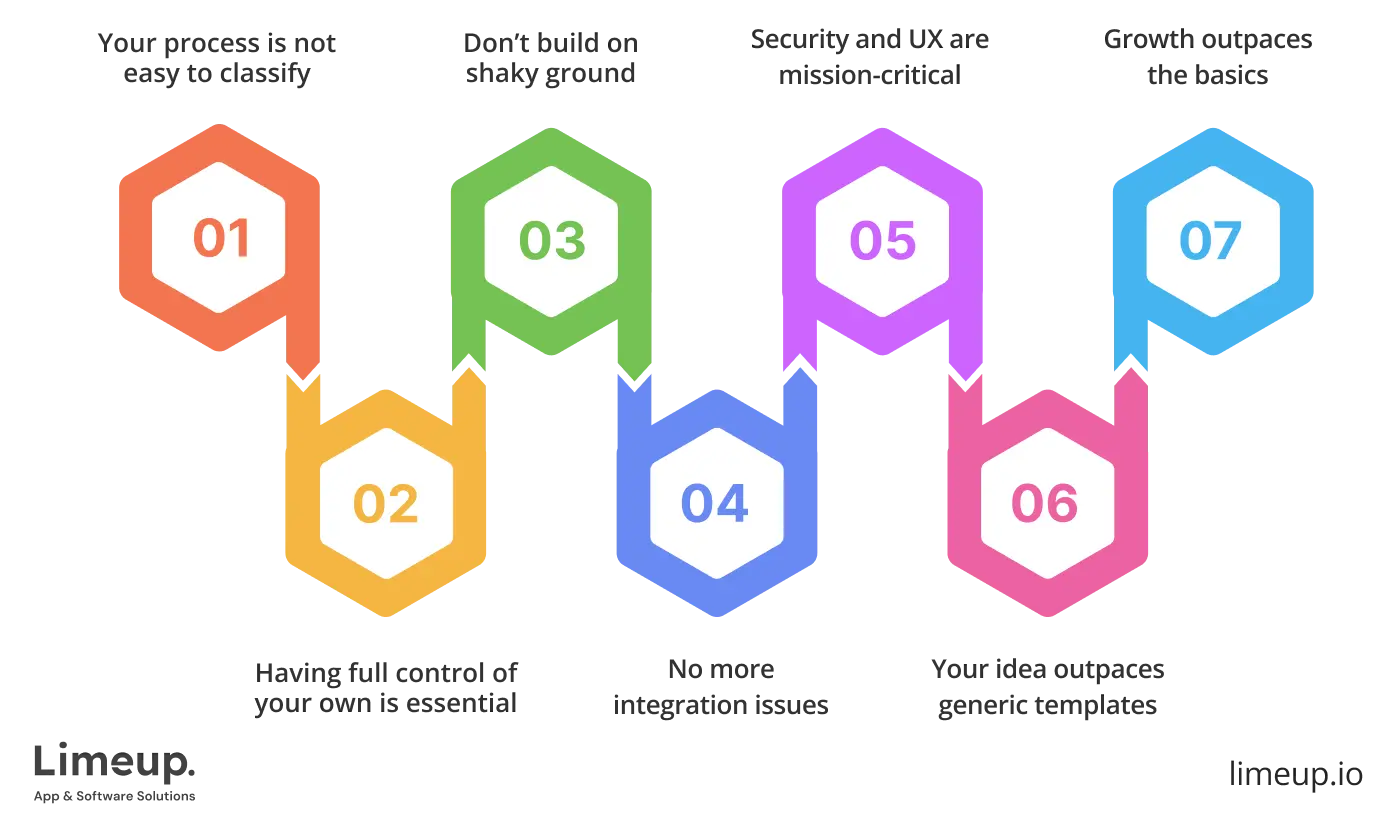
Your process is not easy to classify. A red flag appears if every workday is a mystery because tasks do not fit together like they should. If your workflow is not ordinary, the problems caused by using these platforms become very apparent.
Maybe your customer journey spans multiple channels, or your internal approvals have layers of complexity that templates can’t accommodate. Purpose-built software is built to match your special workflow, allowing it to stay the same.
Having full control of your own is essential. Think about it as a similar experience to buying something instead of renting it long term. When you use configured software, you’re in charge of guiding its changes. You are in charge of selecting which features are important, deciding what to increase or decrease, and setting the time when it should happen.
In the process of creating custom software, update cycles fade away, replaced by tailored solutions with no unnecessary extras — just the sharp tools your business truly requires.
Don’t build on shaky ground. A start-up or a digital product is risky as it is; don’t add more risks by using poorly suited platforms. Pre-built platforms may seem superior, but in the long run, they tend to be less flexible than what new ventures need. Anytime the company needs to adjust direction, it causes stress. By having your development customized, your app gets stronger and more advanced as you update and upgrade it step by step.
Integration headaches? Not anymore. Two main reasons behind this use: (a) each tool addresses a specific area, and (b) each company only uses the tools it actually needs. If you’re juggling five dashboards and three logins just to check inventory, it’s time for a change. Tailor-made systems mesh your business components into one efficient machine. Spend less time troubleshooting, avoid pitfalls, and gain a comprehensive outlook.
Growth outpaces the basics. Trying to reach major business goals using entry-level tools is like climbing a mountain with flip-flops on. It feels fine at first, but the descent quickly gets tricky. To customize software development means your system can grow or shrink alongside your business, never stretching your budget beyond reason.
Security and UX are mission-critical. There are some lines of work that require everything to be handled correctly. If you’re in healthcare, fintech, or anything data-sensitive, security and code ownership aren’t nice-to-haves — they’re non-negotiables. With custom-designed platforms, it is easier to handle risks and ensure compliance. Furthermore, you make a user experience your customers will appreciate, and not just one the market believes in.
Your idea outpaces generic templates. Sometimes, platforms that are too similar can’t support new and innovative ideas. When your concept is original, dramatic, or occupies a niche, software companies make sure it stays the same during development. Today’s major apps began as simple creations with an impressive plan to grow over time.
If pre-made solutions start to fail, it’s actually a good thing. It is not only for addressing problems. It introduces new opportunities. A skilled development team by your side will help you overcome growing pains and make your company grow cleverly.
How to develop custom software: a brief instruction
Crafting custom software requires more effort than getting a blender and hoping it’s fine for your needs. It’s pretty much like getting your own suit made: the fit, style, and everything needed to fit your activities and plans. When your marketing is successful, it complements your business perfectly.
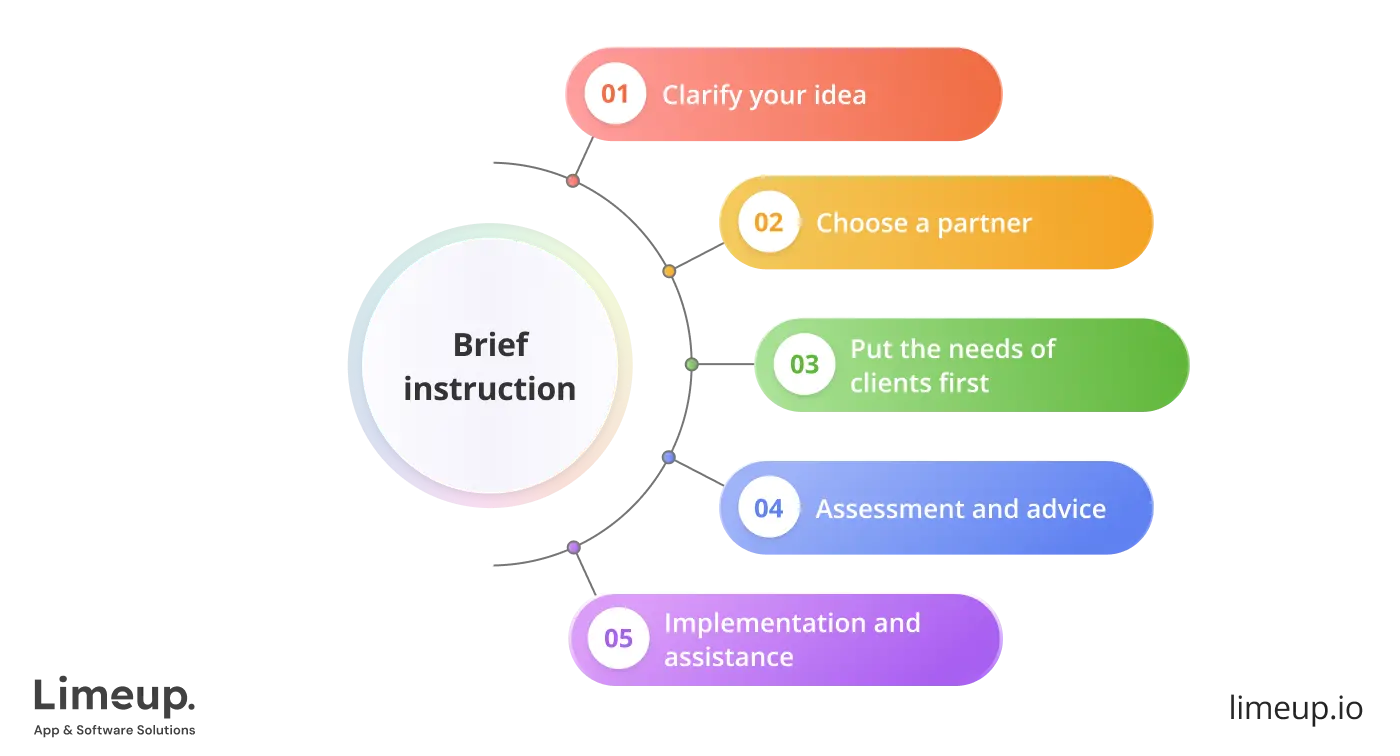
-
Clarify your idea. Beginning by exploring the users’ needs is important. Make sure to list out what your software is designed to accomplish and explain why. Pick out the business dilemma, how a user will explore the service, and what final outcome does everyone want. Should this phase feel uncertain, a reputable outsource agency would take you to workshops and wireframes to guide the vision for you.
Some facts to consider: 7 out of 10 digital change projects usually fail if no clear plan is formed in advance. Treat this as your foundation—if it’s shaky, the whole thing crumbles later.
-
Choose a partner. When you hire developers to create custom software, you’re also selecting people who will be with you for a while. Make sure the development agency has worked on many projects, it’s transparent, and it uses a development process based on iterations. You should aim for a team that explores the reasons behind things, not only the methods used.
Go over case studies, find out what kind of technology they employ, and confirm they know your industry. If they’ve developed tools like yours, they’ll spot the possible issues before you face them.
-
Put the needs of clients first. Efficient use of your platform relies on solid UI/UX design, not just as an extra feature. You can turn your idea into something real during the design phase by making mockups and prototypes. This is your chance to walk in the user’s shoes before the real journey begins.
Everyone prefers a software that looks and runs smoothly. Finalize the current stage before going to the next phase.
- Assessment and advice. How to create custom software becomes clear at this stage, where double standards reveal themselves positively. Yet this is a positive thing. It is where you focus on user tests, assure quality across the platform, test performance and look at accessibility features. A focused outsource software development agency invites actual users to use the app to find anything that’s difficult to grasp.
-
Implementation and assistance. Now you go live. The real work begins post-launch: performance tracking, rollback readiness, user enablement, and collecting field intel to shape your next sprint. Custom software stays relevant only with ongoing care and iteration.
It continues to develop, and having ongoing support makes it stay current: 70% of digital transformations miss their goals mainly because of poor organization and putting them into practice. That is why choosing a partner who knows the details of development is important.
All in all, writing custom code is not something that can be done over a weekend as a side project. A good development process ought to make your software look as though it’s always been an essential part of your company. Make sure the software development company you hire listens to your needs, challenges the way you think about goals, and watches both the final stage and the following developments.
How long does custom software development take?
It’s true that the creation of this kind of software takes different amounts of time for each business. Unfortunately, there are no set guidelines or easy refunds given after three weeks. The speed of a project is determined by the tasks in front of you, how difficult they are, the number of team members, and how well your goals are established at the start.
Consider it to be similar to constructing a house. You can’t just bring in a software developer, develop some code, and settle in on the following Tuesday. Blueprints, the right skills, inspections, and extra room for changes are required. It typically takes between 3 and 6 months to implement a custom software development solution for a company.
Software for companies that deal with more advanced integrations instead? You’re looking at 6 to 12 months — sometimes more if you’re planning multiple feature rollouts or handling sensitive data. Let’s take a look at the main tasks that take up most of our time.
| Stage | Typical duration | What happens |
| Discovery + planning | 2–4 weeks | Requirements, competitor research, user journeys |
| Design (UX/UI) | 3–6 weeks | Wireframes, visual prototypes, user flows |
| Development (MVP) | 2–4 months | Backend, frontend, APIs, database setup |
| Testing | 2–4 weeks | Manual/automated testing, bug fixing, polishing |
| Deployment | 1 week | Final prep, live release, backup setup |
| Post-launch iterations | Ongoing | Based on user feedback, performance data |
Here’s an interesting fact: McKinsey reports that, generally, IT projects take 45% more than the budget and 7% more time than planned. The bright side is generally, the main cause of overly bulky projects is altering scope, cloudy requirements, and fast discovery phases. As long as you select the right company, you won’t get stuck with most of the twists and unexpected issues.

Launching with an MVP allows you to get to market before the window closes. You ship the backbone of the product, stress-test it in the wild, and then build out additional features through continuous delivery. It’s like deploying a lean alpha release with a roadmap ready for growth.
Never forget about the need for regular review cycles. Getting comments and waiting for answers can take much longer than the custom software programming itself. Anyway, being responsive on your end can save a lot of time.
Before you hire a software developer, lock in a roadmap. Get estimates, yes, but look for signs they include buffer time and agile checkpoints. Veteran teams know even the best codebases need refactoring along the way.
Benefits of customized software development
Plug-and-play platforms sound great until you try to force your operations into their predefined boxes. With custom software, you map tech to your process, not the other way around. It’s like pair programming between your goals and your infrastructure.
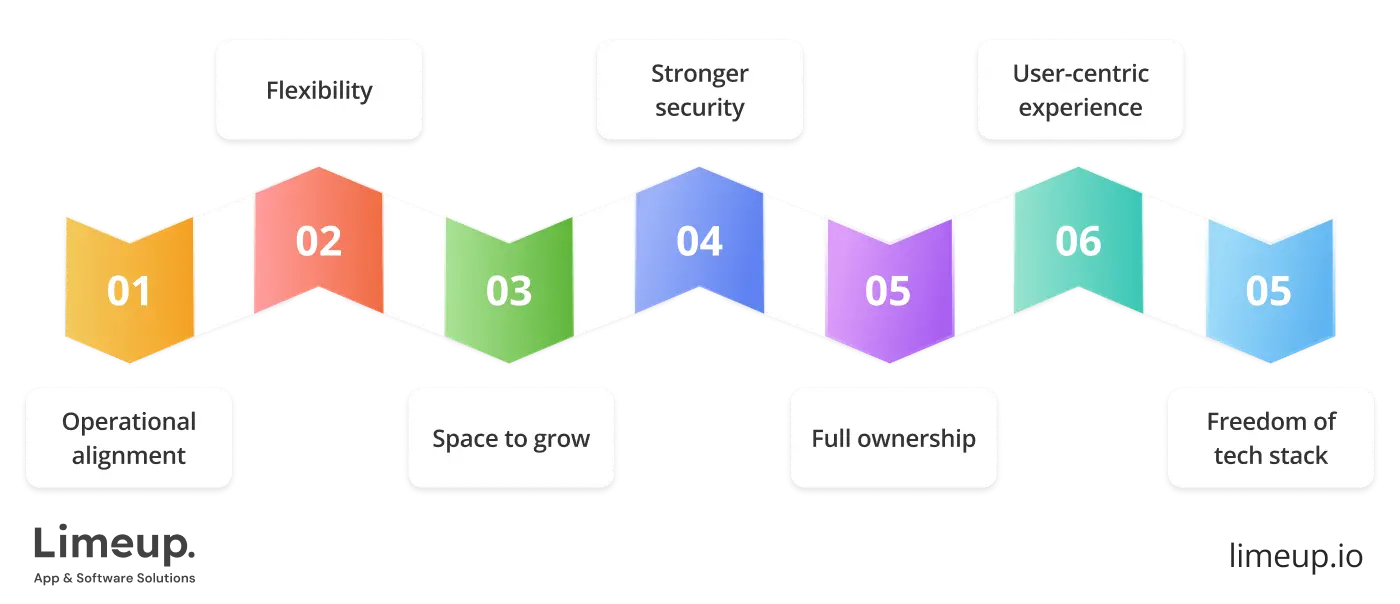
- Operational alignment
Software that is created specifically for your company fits your business activities. You design your internal workflows, rather than following ones given to you. All the tools in your team’s workspace are designed to fit the way people actually handle their jobs.
- Flexibility
To develop custom software is to keep control in your corner. With API-first architecture, you are able to add new services or utilize old ones even without getting approval. In the future, would you like to try out a new feature? Follow the plan you’ve prepared for yourself. There is no need to wait for the next update, and there’s no danger of a tool being discontinued.
- Space to grow
A scalable solution adjusts to business shifts without reengineering the core. Scaling your business up should be matched by growing your software. Custom solutions prepare you for the future, so you won’t run into problems with performance or your process in critical moments.
- Stronger security
Given that data breaches cost millions every year, it is not wise to treat safety lightly. With client-specific software development features, you can equip your product with just the types of protection your business is likely to face.
- Full ownership
When you custom-develop, you are the source code owner. You won’t become stuck with one vendor, encounter expense changes, or rely on another company’s plans. You are in charge of your agenda and goals, without ever relying on your provider to stay.
- User-centric experience
Such software is built for the exclusive use of your team or users. Its functions are great, but even better is how easy it feels to use. When your system speaks your users’ language and anticipates their needs, productivity goes up and frustration drops.
- Freedom of tech stack
Commercial standard-issue programs provide you with their toolkit. In custom development, you select the technology that works in your ecosystem: frameworks, libraries, databases, everything on your terms. Limeup’s toolkit is built for endurance: Flutter crafts stunning UIs, Node.js muscles through backend logic, and PostgreSQL safeguards every byte like a digital vault.
True made-to-order software programming optimizes your operations, granting you ultimate control, perfect clarity, and seamless integration for years to come. This level of “custom” transcends superficial features. When your unique workflows render standard solutions inadequate and your expansion plans brook no compromises, investing in personalization isn’t a speculative venture; it’s a bedrock principle of good business.
Challenges and risks to consider when developing custom software
So, you are interested in bespoke software solutions — a superior choice for many businesses, which can help you achieve smooth operational efforts. Still, creating something custom usually involves overcoming various obstacles along the way.
Building something custom requires caution because knowing the challenges ahead can shield you from troubles, emotional stress, and high expenses after the groundbreaking ceremony. We should consider some of the big challenges and risks that exist when you design your own digital project.
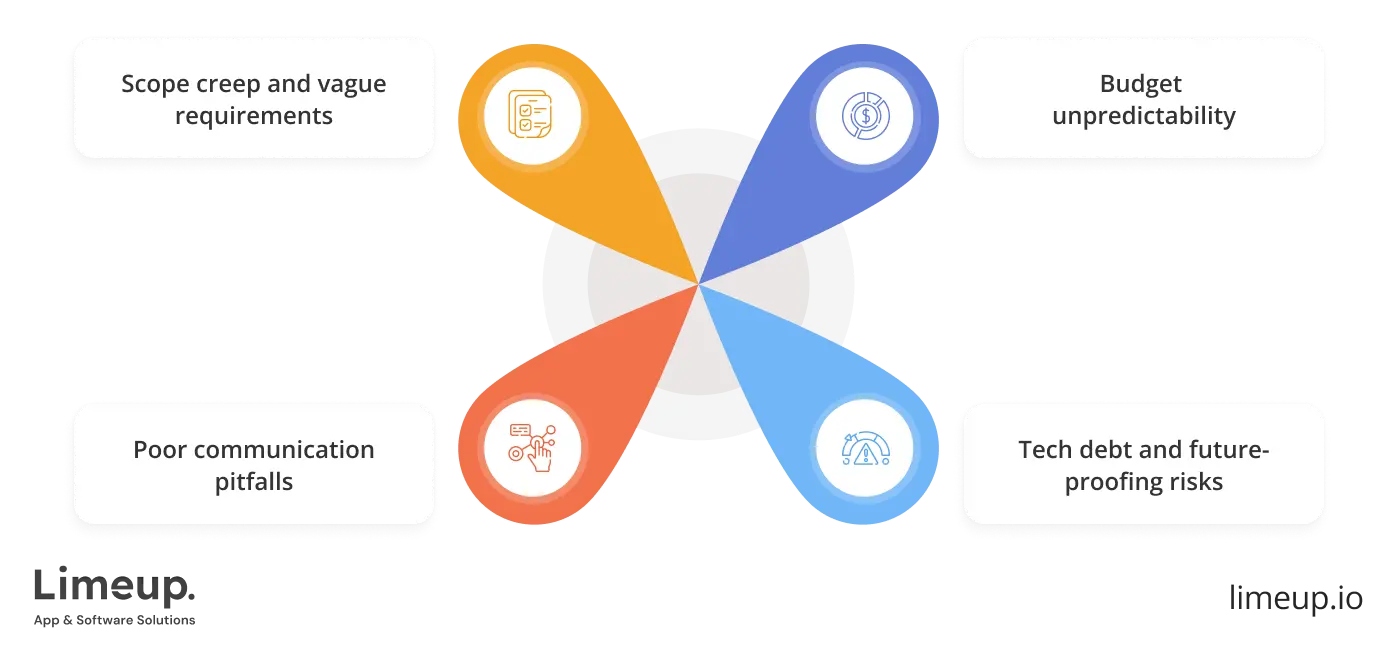
Scope creep and vague requirements
From our decade-long experience, we may state that a significant challenge in bespoke software development arises when initial requirements lack precision. Vagueness in the beginning is a guarantee of missing targets. Custom software developers find themselves competing with a moving target and the end result usually has very little to do with the initial purpose.
As a result, the scope of a project may undergo out-of-control growth, similar to feature creep, causing the deployment of additional resources and time. This may result in time delays and additional costs and clearly, this is not what anyone desires.
Poor communication pitfalls
Clear communication isn’t a nice-to-have as it is like the glue holding personalized software development together. You’re not shopping off a shelf; you’re building side by side. When signals get crossed, small gaps become giant project sinkholes.
Because of the overlap, new features may not be what is needed, and worse, basic elements may entirely disappear from the product. Coordination between all the stakeholders and the development team should be there, which is utterly necessary.
Budget unpredictability
The problem of resource allocation and budgeting is common in bespoke software development. Instead of the set cost approach of commercial off-the-shelf (COTS) solutions, custom projects are an iterative process. There may arise unexpected technicalities, or the business needs may change mid-air.
Even necessary changes may cause the overrun of the budget and a serious delay of the schedules. As such, it is essential to create a feasible financial backup and have a flexible attitude because even the most careful plan can hit a wall with unexpected issues. Here is how you should look at it: 52.7% of software projects go above their initial cost estimates by an average of 189%!
Tech debt and future-proofing risks
In addition, your bespoke software should be designed to provide the best support for years to come. If the technology chosen or test procedures ignored are not suitable, the system might break easily, proving hard to maintain and replace. Imagine spending a lot of time making a beautiful bridge, but it isn’t able to deal with the demand.
The custom software development solutions you choose should be able to last long and update as your business develops and the world of technology changes. Failing to test thoroughly means you could encounter a lot of problems and bugs even after the game is in players’ hands.
After all, there are some difficulties that come with making individual software. But if you watch out for these traps, talk freely with your team, plan well in advance, and work with trustworthy professionals, your odds of success will rise a lot. It involves careful planning, not only depending on things working out well. If implemented correctly, those personalized solutions will help your business achieve great success.
How much does custom software programming cost?
This is really the main question, or maybe a billion-dollar question! Quoting an exact upfront cost for custom software is not easy because its cost can change throughout the process.
There is no magic calculator and no two apps have the same price. Software development is not exactly an off-the-rack suit. It is closer to ordering a tailor who gets to know all your preferences, stitch by stitch. The price tag reflects that attention to detail.
When you hire a team of dedicated developers, you are not buying code only. A well-executed custom software development service breaks down into distinct but critical phases: concepting, research, system design, testing, delivery, and continuous support. That sort of workmanship requires time and ability.
The majority of small-to-mid-sized custom projects fit between $30,000 and $100,000, although the scope may vary based on integrations, features, and complexity. For example:
| Type | Rough estimate |
| MVP for a startup | $25,000–$50,000 |
| Internal dashboard | $30,000–$70,000 |
| Full-feature SaaS | $80,000–$250,000+ |
| Enterprise platform | $150,000 and up |
We’re not throwing darts at a board here. It’s more like configuring enterprise architecture: complexity, scope, and required performance all push the numbers in different directions.
Key factors that influence the cost
The price of recruiting a custom software developer is directly influenced by some major factors. Being aware of these factors assists you in forecasting investments and generating well-informed decisions regarding quality, speed, and money.
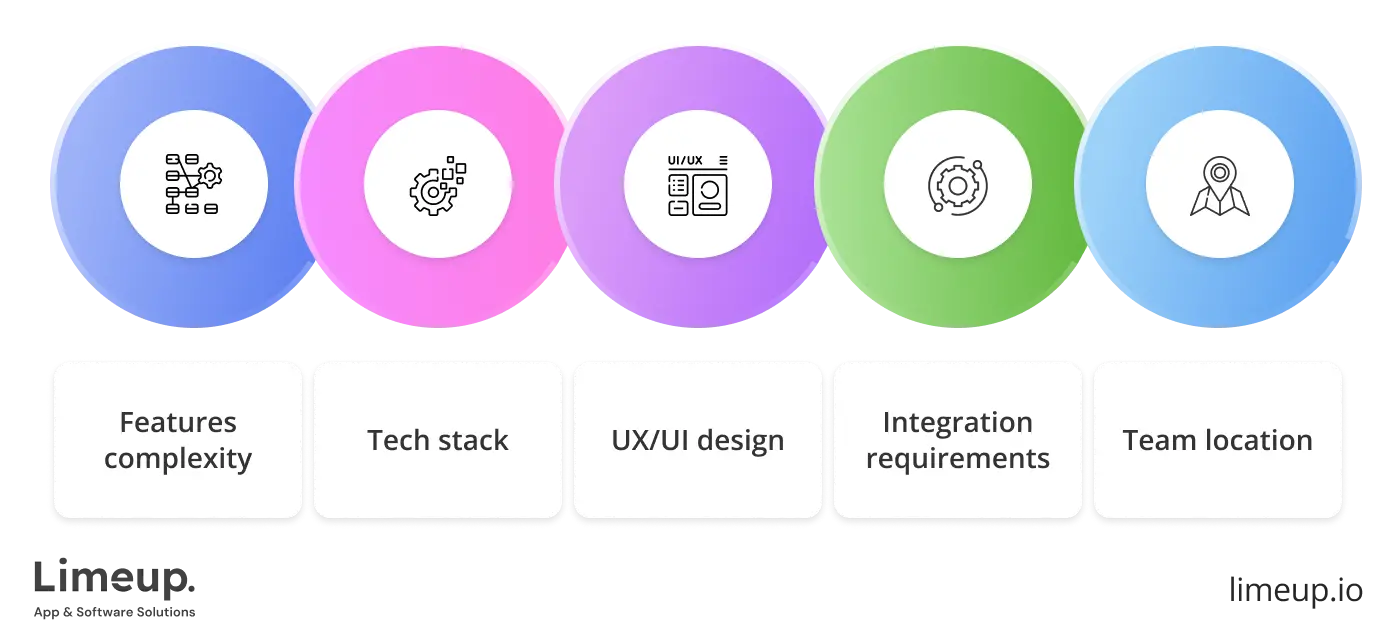
- Complicatedness of features. A simple tool gets you moving. But once you throw in predictive analytics and external APIs, you’re climbing uphill with weights on. More features mean more development cycles, deeper QA, and often, specialized talent to get things done right.
- Tech stack. Some of the tools are faster to make, some require more experienced professionals. Established, supported tech stacks are less risky to use, whereas cutting-edge ones may provide special outcomes, yet typically with a higher cost. Your choice of technology base will affect scalability, performance and overheads of future maintenance.
- UX/UI design. A longer time is required when the UX/UI design of a site must be carried out when you need custom interfaces, motion design, and fluid interactivity. Polished animations or microinteractions can be custom-made, but they also add hours to the design and custom-built software development. Clean, intuitive experience is rewarded with user retention; however, it is an investment.
- Integration requirements. CRMs, ERPs, or payment gateways all require development and testing time to plug in. The more systems that require communication with one another the more complicated your middleware or data synchronization is going to be. In the event that third-party services upgrade or modify their APIs, continuous maintenance will be required as well.
- Team location. Rates differ across the world. Offshore teams can also work for lower rates per hour but will need more project management. To overcome time zones and work styles, offshore teams might require more stringent project management, better documentation, and stronger coordination.
The building of custom software is a marathon. What you pay is based not just on the build, but the vision, flexibility and lifetime of your solution.
Hidden costs to watch for
When starting to customize software development, most eyes are on the launchpad. But the budget overruns often orbit just after takeoff.

- Maintenance and updates. The support after the launch is not free. Bug fixes, performance tuning and all-the-time feature roll out ensure that your platform is stable and relevant. The lack of a plan will cause a small problem escalate to rebuilds.
- Hosting and infrastructure. Servers, databases, storage, and load balancers are monthly costs, and they are usually running on AWS, Azure, or GCP cloud platforms. They include charges that increase with your traffic and usage, and should not be considered flat-line expenses.
- Licensing fees. Third-party tools are not always one-off. APIs, SDKs, libraries, lots of them are sold with yearly or per-use charges. And when your app scales quickly those seemingly inexpensive add-ons can become budget-silent monsters.
- Project management. Planning, sprint tracking, stakeholder updates, all those meetings and syncs do not produce code, but they help the entire machine not to go off course. This is one area where you can skimp and end up with scope creep or communication failures.
- Scaling later. It is usually more expensive to retrofit performance or integrations post-launch than putting them in early. Without a long-term launch strategy, you can easily get into technical debt that consumes your future roadmap.
The more intelligent play: assemble a squad of committed custom software programmers who understand your idea and can guide your project towards a tech debt-free future. They will help you see clearly regarding the timeline, identify roadblocks before they happen, and make trade-offs without making essential corners.
When it is done well, precision-engineered program will repay you in hours saved, efficient processes, and reduced technology frustrations. Not only is that good code, but it is good business.
Latest trends in building custom software
Technology evolves faster than a nightly code deploy. To stay relevant, businesses need to track what’s bubbling up in software development, not for show, but to architect systems that run leaner, scale cleaner, and last longer. Here’s a look under the hood at the trends changing the adapted game.
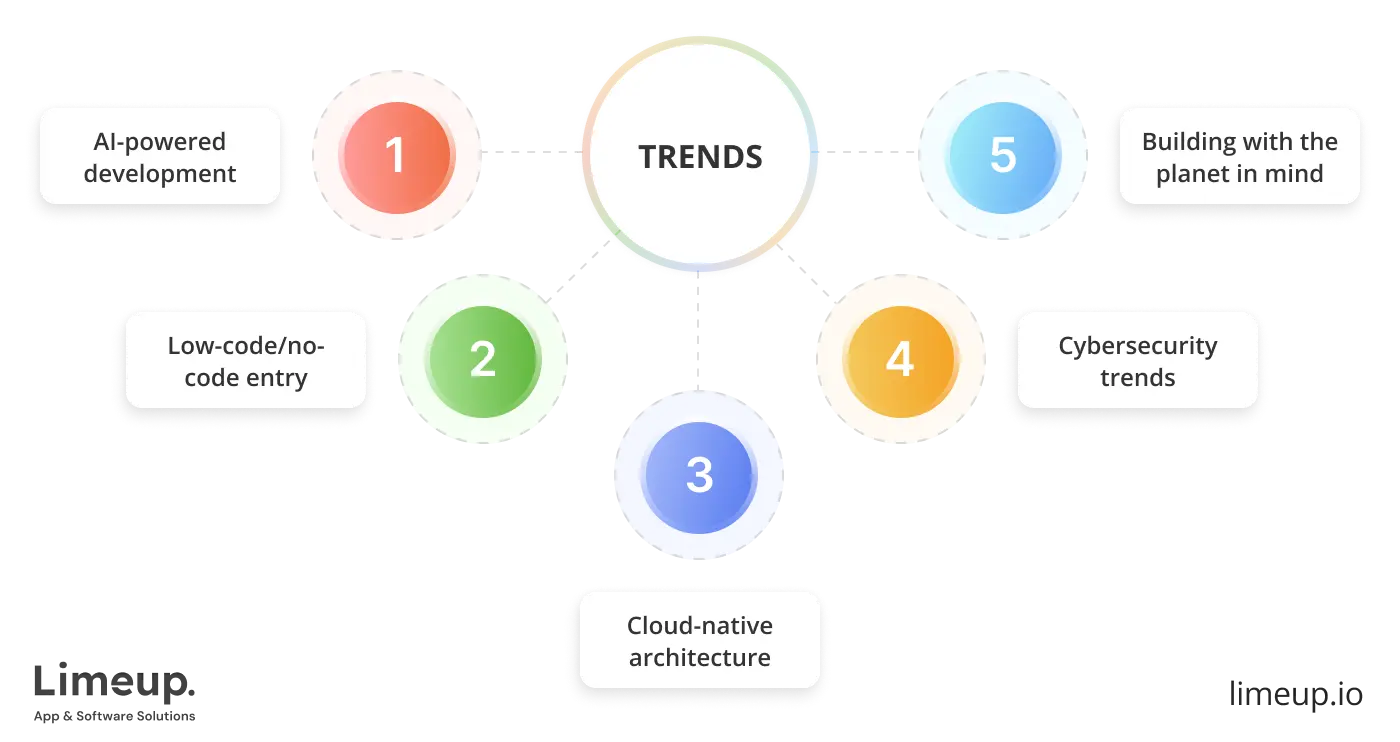
— AI-powered development and automation. AI is no longer a boardroom buzzword technology; it is an engineering workhorse. Nowadays, artificial intelligence is honing the development process: it writes boilerplate code, finds bugs before they go live, and is even able to optimize UI choices with respect to user behavior.
Gartner also predicts that AI assistants will become a daily tool for more than 70% of enterprise software engineers by 2028. This evolution reduces errors and accelerates timelines while letting developers zero in on strategic thinking instead of manual routines.
— Low-code/no-code entry. It is not necessary to write everything using line-by-line hand-coding. Custom development can now be perfectly combined with low-code and no-code platforms. They are well-suited to internal tooling, prototyping, or MVPs constructed at blistering speed.
This hybrid model can get you moving quickly when you need to test an idea with something lean, or when you simply have to ensure that you are not creating bottlenecks. Consider it providing your devs with power tools rather than chisels.
— Cloud-native architecture. Cloud-native architecture is more than a buzz phrase, as it is the foundation of scalable purpose-built software. Serverless models, microservices, and containerization (by Docker and Kubernetes) provide an efficient, modular means of scaling and building.
With custom software programmer, you say bye to pre-made codebases that groan under the pressure. Requiring an additional feature or service scaling? It is just a matter of spinning it up. It is not the lifting of an entire house, merely the replacement of one smart brick.
— Privacy-by-design and cybersecurity trends. As the threats associated with cybersecurity are rapidly outpacing the patching capabilities, security has become an architectural component of software. The best software today is built with data encryption, access controls and compliance tools baked in right from the start.
Privacy rules like GDPR and HIPAA stand shoulder-to-shoulder with technical specs during planning and development. It is no longer fitting a lock after the break-in but fitting a vault right at the drawing board.
— Building with the planet in mind. The tide is turning. Clean, energy-efficient code is becoming part of the spec sheet, not just a nice-to-have. Thoughtful software design now includes a climate lens. Efficient queries and lightweight logic reduce server demand, and that’s energy saved.
Software trends are signals rather than noise. Changes occur with every sprint, and astute teams like Limeup adapt to the changes rather than resisting them. Building with a team or employing a group of committed developers requires keeping up with changes that affect security, scalability, and architecture. Your software’s future hinges on how you frame the build as much as its capabilities.
Limeup’s custom software engineering case study
Building habits is hard but building eco-habits that actually stick? Even harder. That was the challenge Raccoon.recovery set out to solve. The client approached Limeup with a clear vision: a mobile app that not only encourages sustainable behavior but makes the process feel like progress, not pressure. Off-the-shelf tools didn’t cut it, so they turned to a custom full stack web development company for a tailor-made approach.
The business challenge: get sustainability to click
The main idea behind Raccoon was behavioral change, which was to be fueled by technology. The client had a vision of a mobile app that could motivate people to lead more sustainable lives by taking actions in daily life. But this was not ensuring change by force, it was ensuring that change feels good. Achieving success during custom software development rested on locking in these core features:
- Gamification to ensure a high level of motivation.
- A way to track progress visually, so the user would know the difference.
- An ecosystem of individualized objectives that will fit the user experience.
- A slick, contemporary interface that was as easy to use as it was beautiful to examine.
The other off-the-shelf platforms were unable to provide such customization. All the details had to correspond with the vision and purpose of the client. That is what Limeup came in with: a full-cycle, customized approach.
The custom solution: full stack, fully tailored
Being a full stack custom software development company, Limeup assumed control of all the development layers. This project began by conducting profound discovery and UI/UX prototyping. The team took its time to plot user flows and made sure that it was clear, inspiring, and convenient. As soon as the users opened the app, they needed to understand why it was important, and how they were changing lives.
The second step was development, in which Limeup created a native iPhone app (ground up). The main characteristics were:
- A point and level system (gamified) to transform eco-habits into small victories.
- Individualized goal development to indicate various user lifestyles.
- Integration of analytics to monitor behavior patterns and interaction.
- Strict pre-launch testing to prove real-world applicability.
This was not a plug-and-play project. All components, including data storage, rewards logic, were created tailor-made to Raccoon.recovery. No boilerplate. No shortcuts.
Outcome & value delivered
What landed in users’ hands was a highly tailored, gamified app that hit its mark. Engagement metrics climbed, session times extended, and feedback pointed to a design that resonated. The visual system didn’t just look good — it encouraged consistency in eco-friendly habits.
Raccoon achieved strategic alignment with the client’s objectives and delivered user engagement that turned heads. For us, it stood as a clear example that custom software development services are able to translate ambitious ideas into scalable digital solutions that make a difference.
Is custom software right for you?
At some stage, every business reaches a capacity where constraints begin to strain (processes become stretched, templates begin to break and workarounds become commonplace). That’s normally the tell-tale, your digital plumbing has to expand with you and not against you. Where the off-the-shelf tools lose their steam, made-to-order software takes over and provides solutions that are tailored to fit like a glove rather than invite a compromise.
Nevertheless, the choice of building new is not all about ambition, but about accuracy. Generic tools bend your operations to fit their mold. Purpose-built software bends to yours,and keeps bending as you scale. It is not a shortcut, but it is frequently the more intelligent path in the long term that is supported by a team that knows what is at stake and who can communicate in your language of industry.
When you are using the tools you have and they seem like a square peg in a round hole, then it is time to discuss strategy. Limeup is a custom software development team that collaborates with companies to create solutions that endure. No matter which stage you are at, exploring or ready to get started, contact Limeup and convert your thoughts into software that performs.

